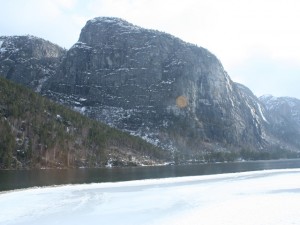The Setesdal valley is a spectacular combination of deep ravines, straight-sided cliffs and rushing rivers. The road follows the river, passing waterfalls, skirting canyons, and weaving through small towns, farms and villages. One of those villages is called Bjørnarå, and I think that’s where my family comes from.
I met a cousin of mine, Cecilie, before I went to Setesdal, and she told me a story about how, when she was filming for one of her documentaries in the Telemark region, she took a taxi and got to talking with the driver. When he learned her name, he knew exactly which part of Setesdal her family came from. I think it must be the village of Bjørnarå.
We have always spelled the name Bjornaraa, but I have noticed since I’ve been in Norway that the å is often rendered aa, especially when written in English. And since the ø doesn’t exist in English, it’s often written as a simple o, even though it sounds more like a short u. So, I’m confident in guessing that the two words are the same.
Cecilie spells her name with 2 a’s and an ø. She’s a fascinating person, and I’m really glad to have met her. We have a connection now beyond just a name, two creatives who share a similar outlook on life and on art. (“Maybe it’s in our blood,” she said, as we discussed the poets and musicians among our ancestors.) She’s a documentary filmmaker, and her interest in anthropology has led her to explore many varied subjects, one of the more recent being contemporary immigration. Its reasons on the surface are obvious, but as she digs deeper, she is finding them to be myriad and unexpected, facts that I think are true of immigration in any time period.
In the early 1900s, Setesdal was the poorest area of one of the poorest countries in Europe. The region sent more immigrants to America than any other in Norway, and Norway sent a higher percentage of its population to the U.S. than any other country, except Ireland. Knowing all that, I was unprepared for the beauty of the region. My camera clicked continuously, and I had to keep pulling off the road to shoot pictures. I think I finally started to understand just how heart-wrenching my family’s decision to emigrate really was, and why they spent so much time remembering their homeland once they got to the U.S. It wasn’t just the family or the familiarity they missed; it was the land itself. The mountains, the forests, the rivers, the gorges. I didn’t want to leave, and I was only there for three days.
The woman who worked at the front desk of the hotel I stayed at grew up in Setesdal. In fact, she grew up on the grounds of the hotel complex: It’s a family affair, and the house sits just behind the cottages and the campground. She loves it, she said, and though she was not speaking her native language, I didn’t get any hint of sarcasm or insincerity. She really does love it. It made me wonder if it’s like the small towns of Alaska in that respect: When we’re kids, we can’t wait until we’re old enough to leave, and then when we do, we can’t wait to get back.
Of course, major changes have happened to the region during the past 100 years, so that it now looks and feels differently than when my great-grandparents lived there. A highway was built through Setesdal in the 1950s, changing what was once an arduous journey into one of relative ease, and allowing outsiders access to a place they might otherwise never have gone. And in the 70s, a dam was built near Evje, on the southern end of the valley and a place where my great-grandparents once lived, which created a lake and thousands of jobs, and power for Norway and many parts of Northern Europe. The Setesdal region is now dependent on tourism and hydropower, and few people are farmers anymore. About half the region’s residents were farmers before the dam was built; now the number is 0.3%.
I didn’t end up meeting any Bjornaraas in Setesdal when I was there. I found the name and number of a local historian who would possibly know about the families in the region, but failed to connect with him before I had to head back to Oslo to return my rental car. But somehow, just being there, seeing the landscape and driving through the areas where my family might have been, gave me a new perspective on their life both before and after immigration. I have been thinking of it as something of an adventure–a frightening one, to be sure, but one that looks forward, toward possibility and reinvention. I hadn’t thought as much about what it cost them to leave, and not only their family, but their land and landscape. This from my journal while I stumbled through the region:
The sun is coming out, glinting off sections of the lake at the foot of the granite cliffs on the other side, lightly dusted on their ledges with last week’s new snow, and now I have another question: How could the Bjornaraas have left this behind?




{ 1 comment… read it below or add one }
Thank you for this entry Britta! I’m so happy that you were able to connect with Cecilie and visit Setesdal! I have shared your entry with my family and of course – Mom!
Happy traveling!